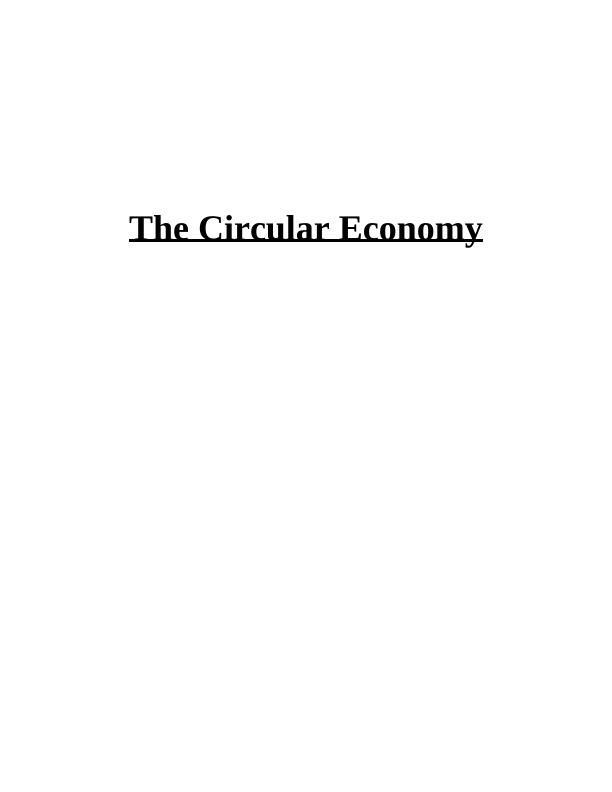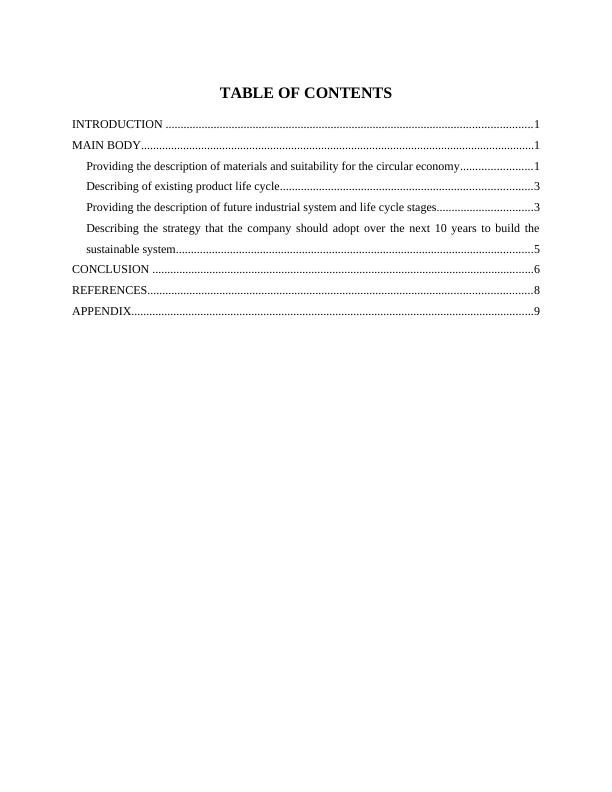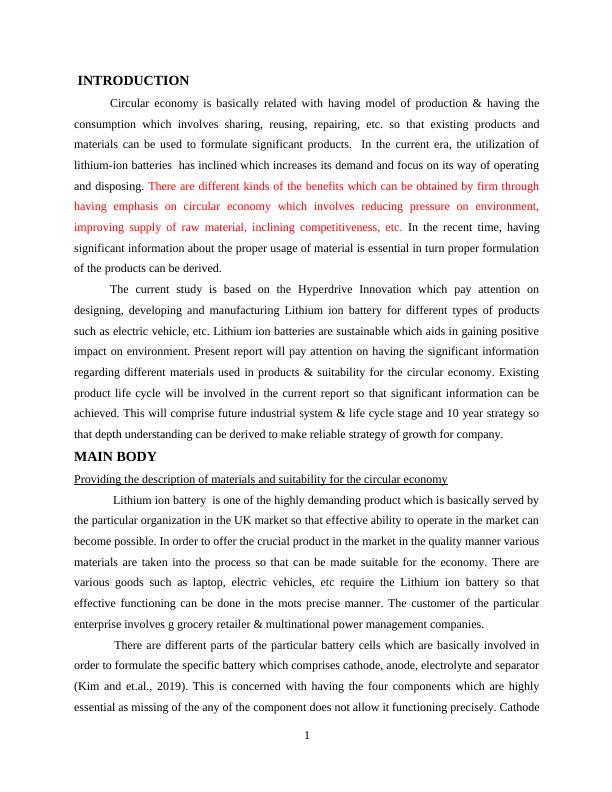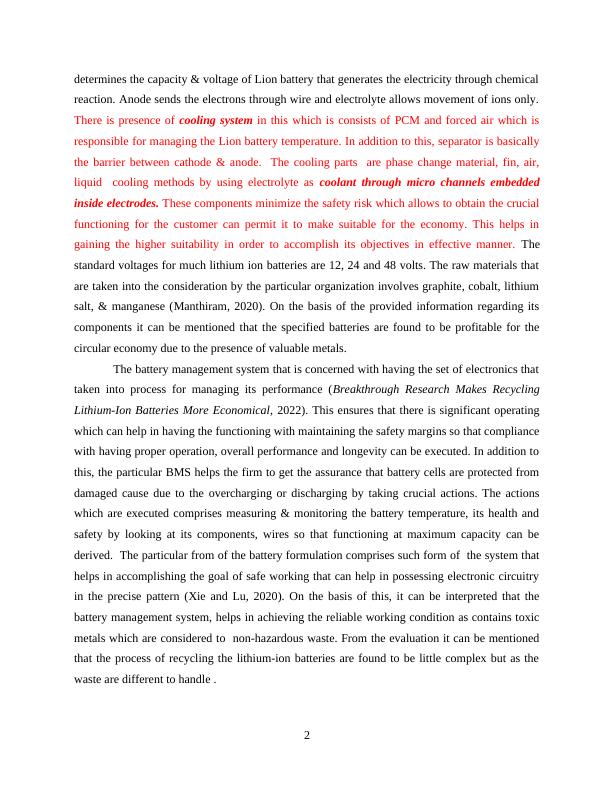The Circular Economy: A Case Study of Hyperdrive Innovation's Lithium-ion Batteries
Added on 2023-06-10
13 Pages3592 Words245 Views
The Circular Economy

TABLE OF CONTENTS
INTRODUCTION ..........................................................................................................................1
MAIN BODY...................................................................................................................................1
Providing the description of materials and suitability for the circular economy........................1
Describing of existing product life cycle....................................................................................3
Providing the description of future industrial system and life cycle stages................................3
Describing the strategy that the company should adopt over the next 10 years to build the
sustainable system.......................................................................................................................5
CONCLUSION ...............................................................................................................................6
REFERENCES................................................................................................................................8
APPENDIX......................................................................................................................................9
INTRODUCTION ..........................................................................................................................1
MAIN BODY...................................................................................................................................1
Providing the description of materials and suitability for the circular economy........................1
Describing of existing product life cycle....................................................................................3
Providing the description of future industrial system and life cycle stages................................3
Describing the strategy that the company should adopt over the next 10 years to build the
sustainable system.......................................................................................................................5
CONCLUSION ...............................................................................................................................6
REFERENCES................................................................................................................................8
APPENDIX......................................................................................................................................9

INTRODUCTION
Circular economy is basically related with having model of production & having the
consumption which involves sharing, reusing, repairing, etc. so that existing products and
materials can be used to formulate significant products. In the current era, the utilization of
lithium-ion batteries has inclined which increases its demand and focus on its way of operating
and disposing. There are different kinds of the benefits which can be obtained by firm through
having emphasis on circular economy which involves reducing pressure on environment,
improving supply of raw material, inclining competitiveness, etc. In the recent time, having
significant information about the proper usage of material is essential in turn proper formulation
of the products can be derived.
The current study is based on the Hyperdrive Innovation which pay attention on
designing, developing and manufacturing Lithium ion battery for different types of products
such as electric vehicle, etc. Lithium ion batteries are sustainable which aids in gaining positive
impact on environment. Present report will pay attention on having the significant information
regarding different materials used in products & suitability for the circular economy. Existing
product life cycle will be involved in the current report so that significant information can be
achieved. This will comprise future industrial system & life cycle stage and 10 year strategy so
that depth understanding can be derived to make reliable strategy of growth for company.
MAIN BODY
Providing the description of materials and suitability for the circular economy
Lithium ion battery is one of the highly demanding product which is basically served by
the particular organization in the UK market so that effective ability to operate in the market can
become possible. In order to offer the crucial product in the market in the quality manner various
materials are taken into the process so that can be made suitable for the economy. There are
various goods such as laptop, electric vehicles, etc require the Lithium ion battery so that
effective functioning can be done in the mots precise manner. The customer of the particular
enterprise involves g grocery retailer & multinational power management companies.
There are different parts of the particular battery cells which are basically involved in
order to formulate the specific battery which comprises cathode, anode, electrolyte and separator
(Kim and et.al., 2019). This is concerned with having the four components which are highly
essential as missing of the any of the component does not allow it functioning precisely. Cathode
1
Circular economy is basically related with having model of production & having the
consumption which involves sharing, reusing, repairing, etc. so that existing products and
materials can be used to formulate significant products. In the current era, the utilization of
lithium-ion batteries has inclined which increases its demand and focus on its way of operating
and disposing. There are different kinds of the benefits which can be obtained by firm through
having emphasis on circular economy which involves reducing pressure on environment,
improving supply of raw material, inclining competitiveness, etc. In the recent time, having
significant information about the proper usage of material is essential in turn proper formulation
of the products can be derived.
The current study is based on the Hyperdrive Innovation which pay attention on
designing, developing and manufacturing Lithium ion battery for different types of products
such as electric vehicle, etc. Lithium ion batteries are sustainable which aids in gaining positive
impact on environment. Present report will pay attention on having the significant information
regarding different materials used in products & suitability for the circular economy. Existing
product life cycle will be involved in the current report so that significant information can be
achieved. This will comprise future industrial system & life cycle stage and 10 year strategy so
that depth understanding can be derived to make reliable strategy of growth for company.
MAIN BODY
Providing the description of materials and suitability for the circular economy
Lithium ion battery is one of the highly demanding product which is basically served by
the particular organization in the UK market so that effective ability to operate in the market can
become possible. In order to offer the crucial product in the market in the quality manner various
materials are taken into the process so that can be made suitable for the economy. There are
various goods such as laptop, electric vehicles, etc require the Lithium ion battery so that
effective functioning can be done in the mots precise manner. The customer of the particular
enterprise involves g grocery retailer & multinational power management companies.
There are different parts of the particular battery cells which are basically involved in
order to formulate the specific battery which comprises cathode, anode, electrolyte and separator
(Kim and et.al., 2019). This is concerned with having the four components which are highly
essential as missing of the any of the component does not allow it functioning precisely. Cathode
1

determines the capacity & voltage of Lion battery that generates the electricity through chemical
reaction. Anode sends the electrons through wire and electrolyte allows movement of ions only.
There is presence of cooling system in this which is consists of PCM and forced air which is
responsible for managing the Lion battery temperature. In addition to this, separator is basically
the barrier between cathode & anode. The cooling parts are phase change material, fin, air,
liquid cooling methods by using electrolyte as coolant through micro channels embedded
inside electrodes. These components minimize the safety risk which allows to obtain the crucial
functioning for the customer can permit it to make suitable for the economy. This helps in
gaining the higher suitability in order to accomplish its objectives in effective manner. The
standard voltages for much lithium ion batteries are 12, 24 and 48 volts. The raw materials that
are taken into the consideration by the particular organization involves graphite, cobalt, lithium
salt, & manganese (Manthiram, 2020). On the basis of the provided information regarding its
components it can be mentioned that the specified batteries are found to be profitable for the
circular economy due to the presence of valuable metals.
The battery management system that is concerned with having the set of electronics that
taken into process for managing its performance (Breakthrough Research Makes Recycling
Lithium-Ion Batteries More Economical, 2022). This ensures that there is significant operating
which can help in having the functioning with maintaining the safety margins so that compliance
with having proper operation, overall performance and longevity can be executed. In addition to
this, the particular BMS helps the firm to get the assurance that battery cells are protected from
damaged cause due to the overcharging or discharging by taking crucial actions. The actions
which are executed comprises measuring & monitoring the battery temperature, its health and
safety by looking at its components, wires so that functioning at maximum capacity can be
derived. The particular from of the battery formulation comprises such form of the system that
helps in accomplishing the goal of safe working that can help in possessing electronic circuitry
in the precise pattern (Xie and Lu, 2020). On the basis of this, it can be interpreted that the
battery management system, helps in achieving the reliable working condition as contains toxic
metals which are considered to non-hazardous waste. From the evaluation it can be mentioned
that the process of recycling the lithium-ion batteries are found to be little complex but as the
waste are different to handle .
2
reaction. Anode sends the electrons through wire and electrolyte allows movement of ions only.
There is presence of cooling system in this which is consists of PCM and forced air which is
responsible for managing the Lion battery temperature. In addition to this, separator is basically
the barrier between cathode & anode. The cooling parts are phase change material, fin, air,
liquid cooling methods by using electrolyte as coolant through micro channels embedded
inside electrodes. These components minimize the safety risk which allows to obtain the crucial
functioning for the customer can permit it to make suitable for the economy. This helps in
gaining the higher suitability in order to accomplish its objectives in effective manner. The
standard voltages for much lithium ion batteries are 12, 24 and 48 volts. The raw materials that
are taken into the consideration by the particular organization involves graphite, cobalt, lithium
salt, & manganese (Manthiram, 2020). On the basis of the provided information regarding its
components it can be mentioned that the specified batteries are found to be profitable for the
circular economy due to the presence of valuable metals.
The battery management system that is concerned with having the set of electronics that
taken into process for managing its performance (Breakthrough Research Makes Recycling
Lithium-Ion Batteries More Economical, 2022). This ensures that there is significant operating
which can help in having the functioning with maintaining the safety margins so that compliance
with having proper operation, overall performance and longevity can be executed. In addition to
this, the particular BMS helps the firm to get the assurance that battery cells are protected from
damaged cause due to the overcharging or discharging by taking crucial actions. The actions
which are executed comprises measuring & monitoring the battery temperature, its health and
safety by looking at its components, wires so that functioning at maximum capacity can be
derived. The particular from of the battery formulation comprises such form of the system that
helps in accomplishing the goal of safe working that can help in possessing electronic circuitry
in the precise pattern (Xie and Lu, 2020). On the basis of this, it can be interpreted that the
battery management system, helps in achieving the reliable working condition as contains toxic
metals which are considered to non-hazardous waste. From the evaluation it can be mentioned
that the process of recycling the lithium-ion batteries are found to be little complex but as the
waste are different to handle .
2

End of preview
Want to access all the pages? Upload your documents or become a member.
Related Documents
Characteristics of Atomic Layer Deposition and Atomic Precise Dot Deposition for Electronic Batterylg...
|7
|1595
|293
The Assignment on Life Cycle Inventory Analysislg...
|5
|820
|18
Circular Economy of Electronic Motorcycleslg...
|16
|4458
|384
Electronic Car Manufacturing Cell Projectlg...
|10
|1880
|235
15 Life Cycle Analysis for Lithium-ion Battery Production and Processing Introductionlg...
|15
|4204
|498
Environmental Impact of Electrical Scooters on Environmentlg...
|16
|4083
|250
